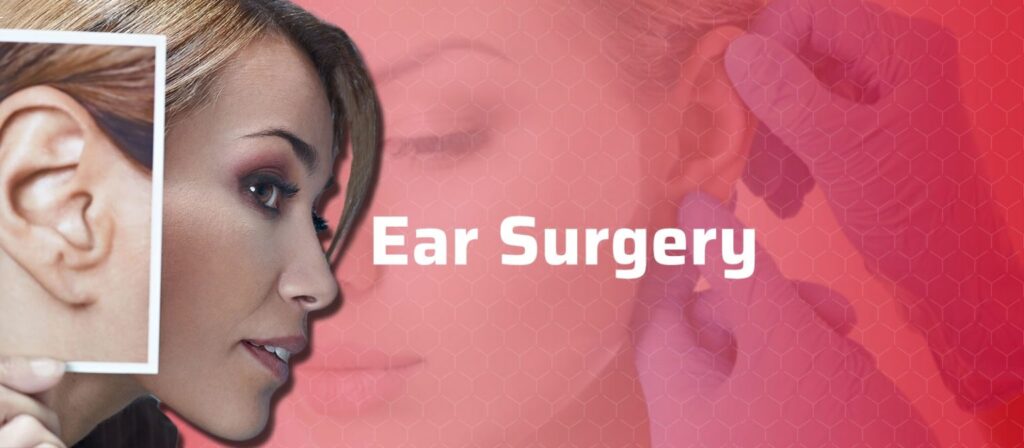What Is Prominent Ear Surgery (Otoplasty)?
Prominent ear surgery, also known as otoplasty or ear pinning surgery, is a cosmetic procedure aimed at reshaping and repositioning the ears closer to the head. This surgery can correct issues such as protruding ears, asymmetry, or deformities like scoop ear and cauliflower ear. Otoplasty is popular among individuals who want to enhance facial symmetry and reduce the appearance of prominent ears. Various techniques are available, including traditional and non-surgical ear pinning options.

How is Prominent Ear Surgery (Otoplasty) Performed?
Otoplasty surgery typically involves making incisions behind the ear to reshape the cartilage, reducing its prominence. Once the ear is adjusted to the desired position, the surgeon uses sutures to hold the new shape securely. This surgery may include ear pin back surgery or ear reshaping surgery to create a more natural appearance. The procedure generally takes one to two hours and can be performed under local or general anesthesia, depending on the patient’s age and comfort level.
Who is a Good Candidate for Ear Surgery?
Good candidates for ear surgery include individuals who:
– Are self-conscious about prominent or asymmetrical ears
– Desire an improvement in ear appearance without major alterations
– Have realistic expectations for the results
– Are in good general health, without underlying conditions that may hinder healing
Both children and adults may benefit from ear correction surgery, though the reasons for pursuing the procedure may differ.
Is There an Age Range for Prominent Ear Surgery?
Otoplasty can be performed on individuals as young as five years old, once the ears have reached full growth. For children, ear pinning can provide a confidence boost before school age. Adults, too, can pursue ear plastic surgery at any stage to correct prominent or asymmetrical ears. Nove Medical’s experienced team can assess each patient’s age, health, and specific needs to determine the best approach.
Prominent Ear Surgery for Children (Otoplasty)
In children, ear pinning surgery is often performed under general anesthesia, with careful attention to the child’s comfort and safety. This procedure helps children feel more confident by reducing noticeable ear protrusion, often before they enter school.
Prominent Ear Surgery for Adults (Otoplasty)
For adults, otoplasty can improve ear appearance and overall facial balance. Many adults opt for ear reshaping surgery to correct issues like asymmetry, cauliflower ear, or cosmetic dissatisfaction, enhancing their appearance and self-esteem.
What Should Be Taken into Account After Prominent Ear Surgery (Otoplasty)?
Post-surgery care is essential for successful healing. Here’s what to consider:
– Pain management: Discomfort can be managed with prescribed pain relievers.
– Protecting the ears: Patients should avoid sleeping on their ears or wearing tight headgear.
– Keeping the area clean: Proper hygiene prevents infection and promotes healing.
– Follow-up visits: Attending follow-up appointments ensures the ears heal correctly and that any issues are addressed promptly.
– Your surgeon will provide specific instructions to help achieve the best results and a smooth recovery.
Frequently Asked Questions About Prominent Ear Surgery:
How Long Does Prominent Ear Surgery Take?
The otoplasty procedure typically takes between one and two hours, depending on the complexity of the correction.
For How Many Days Do Patients Feel Pain After Prominent Ear Surgery?
Most patients experience mild discomfort for the first few days post-surgery, which can be managed with pain medication.
Is Prominent Ear Surgery Easy?
While ear plastic surgery is a straightforward procedure, choosing an experienced surgeon is crucial for achieving optimal results and a safe experience.
When Does the Swelling Go Down After Prominent Ear Surgery?
Swelling from ear pinning surgery usually begins to subside within two weeks, though residual swelling may last for a few months.
Does the Ear Return to Its Former State After Prominent Ear Surgery?
The results of ear pinning are generally permanent, as the cartilage is reshaped and held in position with sutures, reducing the likelihood of the ear returning to its previous shape.
When Does the Prominent Ear Surgery Scar Fade?
The scars from otoplasty are usually minimal and located behind the ears, where they’re less visible. Most scars fade within six months to a year.
How Many Days After the Prominent Ear Surgery Can Patients Take a Shower?
Patients are typically advised to wait 2-3 days before showering, being careful not to get the area excessively wet or rub the ears.
Can the Prominent Ear Be Corrected Without Surgery?
Non-surgical ear pinning or incisionless otoplasty is an option for mild cases and young infants. However, surgical otoplasty is more effective for long-lasting and significant corrections.
Is Otoplasty a Major Surgery?
Otoplasty is generally considered a minor, outpatient procedure, though it requires precision and expertise for optimal results.
How Painful is Otoplasty?
Most patients experience only mild to moderate pain following ear pinning surgery, which can be managed with pain medication.
How Much Does an Otoplasty Cost?
The otoplasty cost can vary depending on factors such as the surgeon’s expertise, the clinic’s location, and the complexity of the procedure. Patients should inquire about ear pinning surgery cost or ear plastic surgery cost during their consultation to get an accurate estimate.
Choosing Nove Medical for Your Ear Surgery Needs
Nove Medical provides personalized care for individuals seeking ear correction surgery, with experienced surgeons specializing in otoplasty and ear reshaping. The clinic offers advanced techniques, including traditional and non-surgical ear pinning options, and transparent pricing on procedures like ear pinning and ear reconstruction. For those considering ear reduction or cosmetic ear surgery, Nove Medical combines expertise, patient-centered care, and high standards to deliver satisfying results tailored to each patient’s needs.
